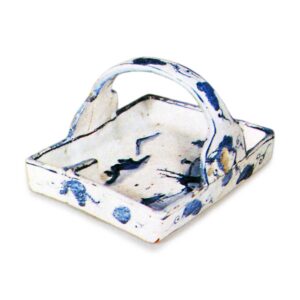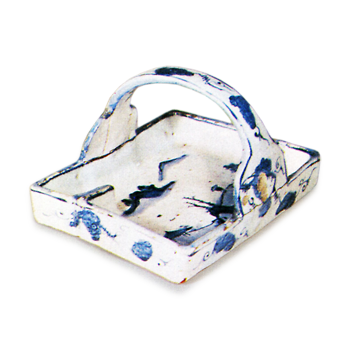
There are two theories about what is called kosozome or kosometsuke. One is that kosozome refers to kotozuke, a name that should be symmetrical with nakadori or shindori, and therefore is necessarily an old type of kosozuke. The other theory is that kozome does not necessarily mean old wickerwork, and if the appearance is quaint, such as insect-eaten, and looks old at first glance, it is called kozome. In any case, kozome is not Japanese pottery, but Chinese pottery that came to Japan. The actual items called kozome by tea ceremony masters and antique dealers are generally recognized as late Ming dynasty dyed ware, and those that seem to be from the Qing dynasty are not called kozome. Kozome, as it is called, is a type of kozome produced in private kilns around the Tianqing (162-7) period of the Ming dynasty, especially when it is considered to be underglaze blue, and there may be even older examples, but they are rare. The old dye varieties include flower vases in the shape of a high sand, water jars in the shape of a handbasket with a crane design, bowls in the shape of Fuji, ginkgo, and autumn leaves, handbowls with a horse design, bowls in the shape of an arhat, fish-shaped bowls with legs, half-fans, yui-mun, zuhama, and jukuri, etc. However, few of these items have survived in China, while in Japan they are quite rare today. In Japan, however, many of these items are still extant. In addition, some of the shapes and designs of these old dyed wares clearly show evidence of having been made to order or exported to Japan. For example, the Fujiyama-shaped bowl and the Goshoguruma no tebachi (hand bowl) are notable examples of this. However, since this type of inferior goods was a common household item in China, there was no one who valued it at the time, and it was all shattered, so that today there is hardly a single piece of it. This is probably the reason why almost no one can find a single piece of it today. On the other hand, once they reached the hands of tea masters, they were sold for large sums of money, and were prized even more than gold, silver, and gemstones. This is the same example of the tea ceremony. The same example can be found in old Korean tea bowls prized by tea masters.
These were once rice bowls for Korean farmers and laborers, and were not valued in Korea because they were inexpensive daily necessities, and the products were quickly shredded. The production area of the old dye was Jingdezhen. (Ozaki Shinsheng)



